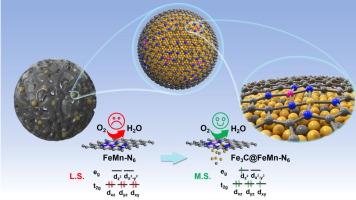以Fe3C为核调谐异核FeMn-N6双位壳中的铁自旋态,促进氧还原反应
IF 13.2
1区 工程技术
Q1 ENGINEERING, CHEMICAL
引用次数: 0
摘要
对于氧还原反应(ORR)而言,精确调节异核双位的电子结构以优化协同效应具有挑战性。本文介绍了一种通过 Fe3C 内核引起的壳应变来调节双位 FeMn-N6 中铁自旋态的策略。通过部分原位聚合,可控地合成了一种新型的 Fe3C@FeMn-N-C 催化剂,该催化剂结合了具有异核 FeMn-N6 双位点的 Fe3C 核和 FeMn-N-C 壳。实验和理论结果表明,Fe3C 引起的外壳应变可将 Fe 的自旋状态调节为中等自旋,从而调整 OO* 和 OH* 的吸附能,激活 FeMn-N6 结构中异核双位点的接力催化。以 Fe3C@FeMn-N6 催化剂为阴极组装的锌-空气电池放电功率密度高达 180.1 mW cm-2,优于商用 Pt/C(120.0 mW cm-2)。这项研究为了解壳应变的电子自旋调制对双位点中继催化的影响提供了新的视角。本文章由计算机程序翻译,如有差异,请以英文原文为准。

Tuning Fe spin state in heteronuclear FeMn-N6 double-site shell by Fe3C core to boost oxygen reduction reaction
Accurately regulating the electronic structure of heteronuclear double-site to optimize synergistic effect is challenging for oxygen reduction reaction (ORR). Herein, a strategy to modulate Fe spin state in double-site FeMn-N6 by the shell strain due to Fe3C core is presented. A novel Fe3C@FeMn-N-C catalyst was controllably synthesized by a partially in-situ polymerization, which incorporates Fe3C core and FeMn-N-C shell with heteronuclear FeMn-N6 double-site. The experimental and theoretical results indicate that, the shell strain caused by Fe3C can regulate Fe spin state to medium spin, thus adjusting the adsorption energy of OO* and OH*, activating the relay catalysis at heteronuclear double-site in FeMn-N6 structure. Zn-air battery assembled with Fe3C@FeMn-N6 catalyst as cathode delivers a remarkable discharge power density (180.1 mW cm−2), outperforming commercial Pt/C (120.0 mW cm−2). This work provides new insights into the influence of electron spin modulation by the shell strain on the double-site relay catalysis.
求助全文
通过发布文献求助,成功后即可免费获取论文全文。
去求助
来源期刊

Chemical Engineering Journal
工程技术-工程:化工
CiteScore
21.70
自引率
9.30%
发文量
6781
审稿时长
2.4 months
期刊介绍:
The Chemical Engineering Journal is an international research journal that invites contributions of original and novel fundamental research. It aims to provide an international platform for presenting original fundamental research, interpretative reviews, and discussions on new developments in chemical engineering. The journal welcomes papers that describe novel theory and its practical application, as well as those that demonstrate the transfer of techniques from other disciplines. It also welcomes reports on carefully conducted experimental work that is soundly interpreted. The main focus of the journal is on original and rigorous research results that have broad significance. The Catalysis section within the Chemical Engineering Journal focuses specifically on Experimental and Theoretical studies in the fields of heterogeneous catalysis, molecular catalysis, and biocatalysis. These studies have industrial impact on various sectors such as chemicals, energy, materials, foods, healthcare, and environmental protection.
 求助内容:
求助内容: 应助结果提醒方式:
应助结果提醒方式:


